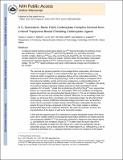| dc.contributor.author | Li, Yang | |
| dc.contributor.author | Wilson, Justin J. | |
| dc.contributor.author | Do, Loi Hung | |
| dc.contributor.author | Apfel, Ulf-Peter | |
| dc.contributor.author | Lippard, Stephen J. | |
| dc.date.accessioned | 2013-11-18T19:39:13Z | |
| dc.date.available | 2013-11-18T19:39:13Z | |
| dc.date.issued | 2012-06 | |
| dc.date.submitted | 2012-05 | |
| dc.identifier.issn | 1477-9226 | |
| dc.identifier.issn | 1477-9234 | |
| dc.identifier.uri | http://hdl.handle.net/1721.1/82459 | |
| dc.description.abstract | A triptycene-based bis(benzoxazole) diacid ligand H[subscript 2]L2[superscript Ph4] bearing sterically encumbering groups was synthesized. Treatment of H[subscript 2]L2[superscript Ph4] with Fe(OTf)[subscript 3] afforded a C[subscript 2]-symmetric trinuclear iron(III) complex, [NaFe[subscript 3](L2[superscript Ph4])[subscript 2](μ[subscript 3]-O)(μ-O[subscript 2]CCPh[subscript 3])[subscript 2](H[subscript 2]O)[subscript 3]](OTf)[subscript 2] (8). The triiron core of this complex adopts the well known “basic iron acetate” structure where the heteroleptic carboxylates, comprising two Ph[subscript 3]CCO[− over 2] and two (L2[superscript Ph4])[superscript 2−] ligands, donate the six carboxylate bridges. The (L2[superscript Ph4])[superscript 2−] ligand undergoes only minor conformational changes upon formation of the complex. | en_US |
| dc.description.sponsorship | National Institute of General Medical Sciences (U.S.) (GM-032134) | en_US |
| dc.language.iso | en_US | |
| dc.publisher | Royal Society of Chemistry, The | en_US |
| dc.relation.isversionof | http://dx.doi.org/10.1039/c2dt31260c | en_US |
| dc.rights | Creative Commons Attribution-Noncommercial-Share Alike 3.0 | en_US |
| dc.rights.uri | http://creativecommons.org/licenses/by-nc-sa/3.0/ | en_US |
| dc.source | PMC | en_US |
| dc.title | A C[subscript 2]-symmetric, basic Fe(iii) carboxylate complex derived from a novel triptycene-based chelating carboxylate ligand | en_US |
| dc.type | Article | en_US |
| dc.identifier.citation | Li, Yang, Justin J. Wilson, Loi H. Do, Ulf-Peter Apfel, and Stephen J. Lippard. “A C2-symmetric, basic Fe(iii) carboxylate complex derived from a novel triptycene-based chelating carboxylate ligand.” Dalton Transactions 41, no. 31 (2012): 9272. | en_US |
| dc.contributor.department | Massachusetts Institute of Technology. Department of Chemistry | en_US |
| dc.contributor.mitauthor | Li, Yang | en_US |
| dc.contributor.mitauthor | Wilson, Justin J. | en_US |
| dc.contributor.mitauthor | Do, Loi Hung | en_US |
| dc.contributor.mitauthor | Apfel, Ulf-Peter | en_US |
| dc.contributor.mitauthor | Lippard, Stephen J. | en_US |
| dc.relation.journal | Dalton Transactions | en_US |
| dc.eprint.version | Author's final manuscript | en_US |
| dc.type.uri | http://purl.org/eprint/type/JournalArticle | en_US |
| eprint.status | http://purl.org/eprint/status/PeerReviewed | en_US |
| dspace.orderedauthors | Li, Yang; Wilson, Justin J.; Do, Loi H.; Apfel, Ulf-Peter; Lippard, Stephen J. | en_US |
| dc.identifier.orcid | https://orcid.org/0000-0002-1577-2420 | |
| dc.identifier.orcid | https://orcid.org/0000-0002-2693-4982 | |
| dspace.mitauthor.error | true | |
| mit.license | OPEN_ACCESS_POLICY | en_US |
| mit.metadata.status | Complete | |
